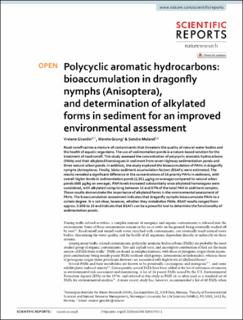| dc.contributor.author | Girardin, Viviane | |
| dc.contributor.author | Grung, Merete | |
| dc.contributor.author | Meland, Sondre | |
| dc.date.accessioned | 2020-09-08T12:49:38Z | |
| dc.date.available | 2020-09-08T12:49:38Z | |
| dc.date.created | 2020-08-03T17:01:09Z | |
| dc.date.issued | 2020 | |
| dc.identifier.citation | Scientific Reports. 2020, 10 . | |
| dc.identifier.issn | 2045-2322 | |
| dc.identifier.uri | https://hdl.handle.net/11250/2676914 | |
| dc.description.abstract | Road runoff carries a mixture of contaminants that threatens the quality of natural water bodies and the health of aquatic organisms. The use of sedimentation ponds is a nature-based solution for the treatment of road runoff. This study assessed the concentration of polycyclic aromatic hydrocarbons (PAHs) and their alkylated homologues in sediment from seven highway sedimentation ponds and three natural urban ponds. In addition, the study explored the bioaccumulation of PAHs in dragonfly nymphs (Anisoptera). Finally, biota-sediment accumulation factors (BSAFs) were estimated. The results revealed a significant difference in the concentrations of 16 priority PAHs in sediment, with overall higher levels in sedimentation ponds (2,911 µg/kg on average) compared to natural urban ponds (606 µg/kg on average). PAH levels increased substantially once alkylated homologues were considered, with alkylated comprising between 42 and 87% of the total PAH in sediment samples. These results demonstrate the importance of alkylated forms in the environmental assessment of PAHs. The bioaccumulation assessment indicates that dragonfly nymphs bioaccumulate PAHs to a certain degree. It is not clear, however, whether they metabolize PAHs. BSAF results ranged from approx. 0.006 to 10 and indicate that BSAFs can be a powerful tool to determine the functionality of sedimentation ponds. | |
| dc.language.iso | eng | |
| dc.title | Polycyclic aromatic hydrocarbons: bioaccumulation in dragonfly nymphs (Anisoptera), and determination of alkylated forms in sediment for an improved environmental assessment | |
| dc.type | Peer reviewed | |
| dc.type | Journal article | |
| dc.description.version | publishedVersion | |
| dc.source.pagenumber | 14 | |
| dc.source.volume | 10 | |
| dc.source.journal | Scientific Reports | |
| dc.identifier.doi | 10.1038/s41598-020-67355-1 | |
| dc.identifier.cristin | 1821426 | |
| dc.relation.project | Norges forskningsråd: 160016 | |
| cristin.ispublished | true | |
| cristin.fulltext | original | |
| cristin.qualitycode | 1 | |
